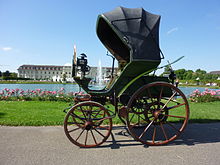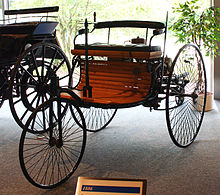HISTORY OF AUTOMOBILE
Development started as early as the 17th century with the invention of the first steam-powered vehicle, which led to the creation of the first steam-powered automobile capable of human transportation, built by Nicolas-Joseph Cugnot in 1769. Inventors began to branch out at the start of the 19th century, creating the de Rivas engine, one of the first internal combustion engines, and an early electric motor. Samuel Brown later tested the first industrially applied internal combustion engine in 1826.
Power sources
The early history of the automobile was concentrated on the search for a reliable portable power unit to propel the vehicle.
Steam-powered wheeled vehicles
17th and 18th centuries
Ferdinand Verbiest, a member of a Jesuit mission in China, built a steam-powered vehicle around 1672 as a toy for the Kangxi Emperor. It was small-scale and could not carry a driver but it was, quite possibly, the first working steam-powered vehicle ('auto-mobile'). Steam-powered self-propelled vehicles large enough to transport people and cargo were first devised in the late 18th century. Nicolas-Joseph Cugnot demonstrated his fardier à vapeur ("steam dray"), an experimental steam-driven artillery tractor, in 1770 and 1771. As Cugnot's design proved to be impractical, his invention was not developed in his native France. The center of innovation shifted to Great Britain. By 1784, William Murdoch had built a working model of a steam carriage in Redruth and in 1801 Richard Trevithick was running a full-sized vehicle on the roads in Camborne. The first automobile patent in the United States was granted to Oliver Evans on May 3, 1789.
19th century
During the 19th century, attempts were made to introduce practical steam-powered vehicles. Innovations such as hand brakes, multi-speed transmissions and better steering developed. Some commercially successful vehicles provided mass transit until a backlash against these large vehicles resulted in the passage of legislation such as the United Kingdom Locomotive Act (1865), which required many self-propelled vehicles on public roads to be preceded by a man on foot waving a red flag and blowing a horn. This effectively halted road auto development in the UK for most of the rest of the 19th century; inventors and engineers shifted their efforts to improvements in railway locomotives. The law was not repealed until 1896, although the need for the red flag was removed in 1878.
In 1816, a professor at Prague Polytechnic, Josef Bozek, built an oil-fired steam car. Walter Hancock, builder and operator of London steam buses, in 1838 built a 2-seated car phaeton.
In 1867, Canadian jeweller Henry Seth Taylor demonstrated his 4-wheeled "steam buggy" at the Stanstead Fair in Stanstead, Quebec and again the following year. The basis of the buggy, which he began building in 1865, was a high-wheeled carriage with bracing to support a two-cylinder steam engine mounted on the floor.
One of the first "real" automobiles was produced in 1873 by Frenchman Amédée Bollée in Le Mans, who built self-propelled steam road vehicles to transport groups of passengers.
The first automobile suitable for use on existing wagon roads in the United States was a steam-powered vehicle invented in 1871 by Dr. J.W. Carhart, a minister of the Methodist Episcopal Church, in Racine, Wisconsin.It induced the State of Wisconsin in 1875 to offer a $10,000 award to the first to produce a practical substitute for the use of horses and other animals. They stipulated that the vehicle would have to maintain an average speed of more than 5 miles per hour (8 km/h) over a 200-mile (320 km) course. The offer led to the first city to city automobile race in the United States, starting on 16 July 1878 in Green Bay, Wisconsin, and ending in Madison, Wisconsin, via Appleton, Oshkosh, Waupun, Watertown, Fort Atkinson, and Janesville. While seven vehicles were registered, only two started to compete: the entries from Green Bay and Oshkosh. The vehicle from Green Bay was faster, but broke down before completing the race. The Oshkosh finished the 201-mile (323 km) course in 33 hours and 27 minutes, and posted an average speed of six miles per hour. In 1879, the legislature awarded half the prize.
20th century
- Pre WWII
Steam-powered road vehicles, both cars and wagons, reached the peak of their development in the early 1930s with fast-steaming lightweight boilers and efficient engine designs. Internal combustion engines also developed greatly during WWI, becoming simpler to operate and more reliable. The development of the high-speed diesel engine from 1930 began to replace them for wagons, accelerated in the UK by tax changes making steam wagons uneconomic overnight. Although a few designers continued to advocate steam power, no significant developments in the production of steam cars took place after Doble in 1931.
- Post-WWII
Whether steam cars will ever be reborn in later technological eras remains to be seen. Magazines such as Light Steam Power continued to describe them into the 1980s. The 1950s saw interest in steam-turbine cars powered by small nuclear reactors (this was also true of aircraft), but the dangers inherent in nuclear fission technology soon killed these ideas.
Electric automobiles
19th century
In 1828, Ányos Jedlik, a Hungarian who invented an early type of electric motor, created a tiny model car powered by his new motor. In 1834, Vermont blacksmith Thomas Davenport, the inventor of the first American DC electric motor, installed his motor in a small model car, which he operated on a short circular electrified track. In 1835, Professor Sibrandus Stratingh of Groningen, the Netherlands and his assistant Christopher Becker created a small-scale electrical car, powered by non-rechargeable primary cells. In 1838, Scotsman Robert Davidson built an electric locomotive that attained a speed of 4 miles per hour (6 km/h). In England, a patent was granted in 1840 for the use of tracks as conductors of electric current, and similar American patents were issued to Lilley and Colten in 1847.
Sources point to different creations as the first electric car. Between 1832 and 1839 (the exact year is uncertain) Robert Anderson of Scotland invented a crude electric carriage, powered by non-rechargeable primary cells. In November 1881, French inventor Gustave Trouvé demonstrated a working three-wheeled car powered by electricity at the International Exposition of Electricity, Paris. English inventor Thomas Parker, who was responsible for innovations such as electrifying the London Underground, overhead tramways in Liverpool and Birmingham, and the smokeless fuel coalite, built the first production electric car in London in 1884, using his own specially designed high-capacity rechargeable batteries. However, others regard the Flocken Elektrowagen of 1888 by German inventor Andreas Flocken as the first true electric car.
20th century
Electric cars enjoyed popularity between the late 19th century and early 20th century, when electricity was among the preferred methods for automobile propulsion, providing a level of comfort and ease of operation that could not be achieved by the gasoline cars of the time. Advances in internal combustion technology, especially the electric starter, soon rendered this advantage moot; the greater range of gasoline cars, quicker refueling times, and growing petroleum infrastructure, along with the mass production of gasoline vehicles by companies such as the Ford Motor Company, which reduced prices of gasoline cars to less than half that of equivalent electric cars, led to a decline in the use of electric propulsion, effectively removing it from important markets such as the United States by the 1930s. 1997 saw the Toyota RAV4 EV and the Nissan Altra, the first production battery electric cars to use NiMH and Li-ion batteries (instead of heavier lead acid) respectively.
21st century
In recent years, increased concerns over the environmental impact of gasoline cars, higher gasoline prices, improvements in battery technology, and the prospect of peak oil have brought about renewed interest in electric cars, which are perceived to be more environmentally friendly and cheaper to maintain and run, despite high initial costs.
Internal combustion engines
Gas mixtures
Early attempts at making and using internal combustion engines were hampered by the lack of suitable fuels, particularly liquids, therefore the earliest engines used gas mixtures.
Early experimenters used gases. In 1806, Swiss engineer François Isaac de Rivaz built an engine powered by internal combustion of a hydrogen and oxygen mixture.In 1826, Englishman Samuel Brown tested his hydrogen-fuelled internal combustion engine by using it to propel a vehicle up Shooter's Hill in south-east London. Belgian-born Etienne Lenoir's Hippomobile with a hydrogen-gas-fuelled one-cylinder internal combustion engine made a test drive from Paris to Joinville-le-Pont in 1860, covering some nine kilometres in about three hours. A later version was propelled by coal gas. A Delamare-Deboutteville vehicle was patented and trialled in 1884.
Gasoline
About 1870, in Vienna, Austria (then the Austro-Hungarian Empire), inventor Siegfried Marcus put a liquid-fuelled internal combustion engine on a simple handcart which made him the first man to propel a vehicle by means of gasoline. Today, this car is known as "the first Marcus car". In 1883, Marcus secured a German patent for a low-voltage ignition system of the magneto type; this was his only automotive patent. This design was used for all further engines and the four-seat "second Marcus car" of 1888/89. This ignition, in conjunction with the "rotating-brush carburetor", made the second car's design innovative. His second car is on display at the Technical Museum in Vienna. During his lifetime, he was honored as the originator of the motorcar but his place in history was all but erased by the Nazis during World War II. Because Marcus was of Jewish descent, the Nazi propaganda office ordered his work to be destroyed, his name expunged from future textbooks, and his public memorials removed, giving credit instead to Karl Benz.
Several inventors developed their own version of practical automobiles with petrol/gasoline-powered internal combustion engines in the last two decades of the 19th century: Karl Benz built his first automobile in 1885 in Mannheim. Benz was granted a patent for his automobile on 29 January 1886,and began the first production of automobiles in 1888, after Bertha Benz, his wife, had proved – with the first long-distance trip in August 1888, from Mannheim to Pforzheim and back – that the horseless coach was capable of extended travel. Since 2008 a Bertha Benz Memorial Route commemorates this event.
Soon after, Gottlieb Daimler and Wilhelm Maybach in Stuttgart in 1889 designed a vehicle from scratch to be an automobile, rather than a horse-drawn carriage fitted with an engine. They also are usually credited with invention of the first motorcycle in 1886, but Italy's Enrico Bernardi of the University of Padua, in 1882, patented a 0.024 horsepower (17.9 W) 122 cc (7.4 cu in) one-cylinder petrol motor, fitting it into his son's tricycle, making it at least a candidate for the first automobile and first motorcycle.Bernardi enlarged the tricycle in 1892 to carry two adults.
The first four-wheeled petrol-driven automobile in Britain was built in Walthamstow by Frederick Bremer in 1892. Another was made in Birmingham in 1895 by Frederick William Lanchester, who also patented the disc brake. The first electric starter was installed on an Arnold, an adaptation of the Benz Velo, built in Kent between 1895 and 1898.
George Foote Foss of Sherbrooke, Quebec built a single-cylinder gasoline car in 1896 which he drove for 4 years, ignoring city officials' warnings of arrest for his "mad antics.
In all the turmoil, many early pioneers are nearly forgotten. In 1891, John William Lambert built a three-wheeler in Ohio City, Ohio, which was destroyed in a fire the same year, while Henry Nadig constructed a four-wheeler in Allentown Pennsylvania. It is likely they were not the only ones.
SOURCE: WIKIPEDIA








Comments
Post a Comment